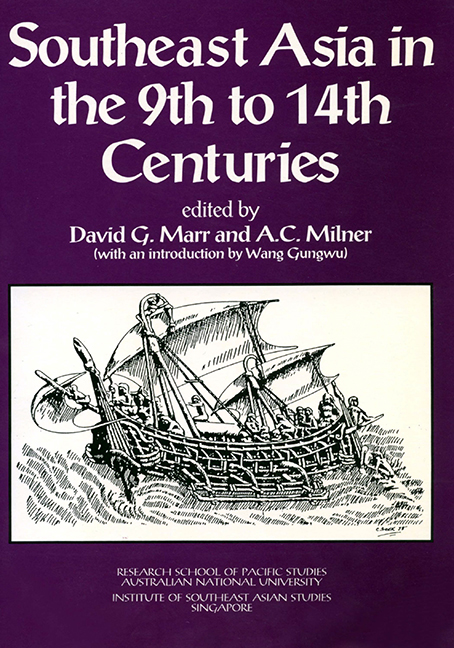Book contents
- Frontmatter
- Contents
- Contributors
- Preface
- Introduction
- 1 The Early and the Imperial Kingdom in Southeast Asian History
- 2 Hydraulic Works and South East Asian Polities
- 3 Some Notes on Relations between Central and Local Government in Ancient Java
- 4 Negara, Mandala, and Despotic State: Images of Early Java
- 5 Some Remarks on Early State Formation in Cambodia
- 6 “Elephants Can Actually Swim”: Contemporary Chinese Views of Late Ly Dai Viet
- 7 Authority and Legitimacy in 11th Century Vietnam
- 8 From Myth to History: Imagined Polities in 14th Century Vietnam
- 9 Shipshape Societies: Boat Symbolism and Political Systems in Insular Southeast Asia
- 10 Changing Perspectives in Island Southeast Asia
- 11 Political and Cultural Continuities at Dvaravati Sites
- 12 The True and the Corbel Arch in Mainland Southeast Asian Monumental Architecture
- 13 Vietnamese Ceramics and Cultural Identity: Evidence from the Ly and Tran Dynasties
- 14 Traditions, Acculturation, Renovation: The Evolutional Pattern of Vietnamese Culture
- 15 Symbolism of Kingship in Arakan
- 16 Buddhism in Champa
- 17 The Ordering of Generations: Change and Continuity in Old Javanese Kinship
- 18 Sources on Economic Activities in Khmer and Cham Lands
- 19 Narrative Bas-Reliefs at Candi Surawana
- 20 Possibilities for a Reading of the 1293-1357 Period in the Vietnamese Annals
- Index
- Miscellaneous Endmatter
9 - Shipshape Societies: Boat Symbolism and Political Systems in Insular Southeast Asia
Published online by Cambridge University Press: 21 October 2015
- Frontmatter
- Contents
- Contributors
- Preface
- Introduction
- 1 The Early and the Imperial Kingdom in Southeast Asian History
- 2 Hydraulic Works and South East Asian Polities
- 3 Some Notes on Relations between Central and Local Government in Ancient Java
- 4 Negara, Mandala, and Despotic State: Images of Early Java
- 5 Some Remarks on Early State Formation in Cambodia
- 6 “Elephants Can Actually Swim”: Contemporary Chinese Views of Late Ly Dai Viet
- 7 Authority and Legitimacy in 11th Century Vietnam
- 8 From Myth to History: Imagined Polities in 14th Century Vietnam
- 9 Shipshape Societies: Boat Symbolism and Political Systems in Insular Southeast Asia
- 10 Changing Perspectives in Island Southeast Asia
- 11 Political and Cultural Continuities at Dvaravati Sites
- 12 The True and the Corbel Arch in Mainland Southeast Asian Monumental Architecture
- 13 Vietnamese Ceramics and Cultural Identity: Evidence from the Ly and Tran Dynasties
- 14 Traditions, Acculturation, Renovation: The Evolutional Pattern of Vietnamese Culture
- 15 Symbolism of Kingship in Arakan
- 16 Buddhism in Champa
- 17 The Ordering of Generations: Change and Continuity in Old Javanese Kinship
- 18 Sources on Economic Activities in Khmer and Cham Lands
- 19 Narrative Bas-Reliefs at Candi Surawana
- 20 Possibilities for a Reading of the 1293-1357 Period in the Vietnamese Annals
- Index
- Miscellaneous Endmatter
Summary
Boat motives appearing in various Southeast Asian cultural contexts were first described in detail when the subject attracted the attention of scholars in the 1930's. On the one hand, Steinraann analysed the motive in terms of the “cult ship”: starting from the description of the Lampung ship-cloths, he compared their motives with those appearing in shamanistic death rituals among the Dayaks and with the famous Bronze Age canoes of the Đông-son drums. On the other hand, Vroklage concentrated on Eastern Indonesia; except for the occasional comparison of the “death-ship” motive with the Greeks' crossing of the river Styx, for a brief outline analysis of the relationship of boat motives with the then popular “megalithic culture”, or for the repeated mention of the ancient migratory voyage as the origin of the social patterns under discussion, his various articles are basically descriptive.[1]
Scattered references to the subject appeared occasionally after the War, but it is only during this last decade that the two previous trends have clearly been revived. Art historians, particularly specialists of textiles, have devoted a fair amount of work to the Lampung ship-cloths and to their role in this Sumatran society.[2] The Eastern Indonesian “field of studies” has similarly been the object of renewed interest from a large number of well-trained anthropologists who have used sophisticated analytical tools to study boat symbolism and its meaning within the global social systems they dealt with.[3]
However, to this point, little has been don-e to integrate in a broader geographical and chronological framework the multiple references to boat symbolism in Insular Southeast Asia. This paper will be an attempt at that, but it will concentrate on one single level of the symbolic discourse, which is that, as we shall see, of the boat as a metaphor for the ordered social group (leaving aside, among others, the higher encompassing macrocosmic order). The relationship of symbolic statements about boats and overseas sailing with exchange systems, the founding of political systems and the legitimisation of political power I will also leave aside in this paper.
The retrieval from various categories of historical and anthropological sources of statements pertaining to this specific level of symbolism will shed some light on the development of political systems of the whole of Insular Southeast Asia. I will try to answer the questions posed with, as far as possible, an historian's feeling.
- Type
- Chapter
- Information
- Southeast Asia in the 9th to 14th Centuries , pp. 187 - 214Publisher: ISEAS–Yusof Ishak InstitutePrint publication year: 1986

